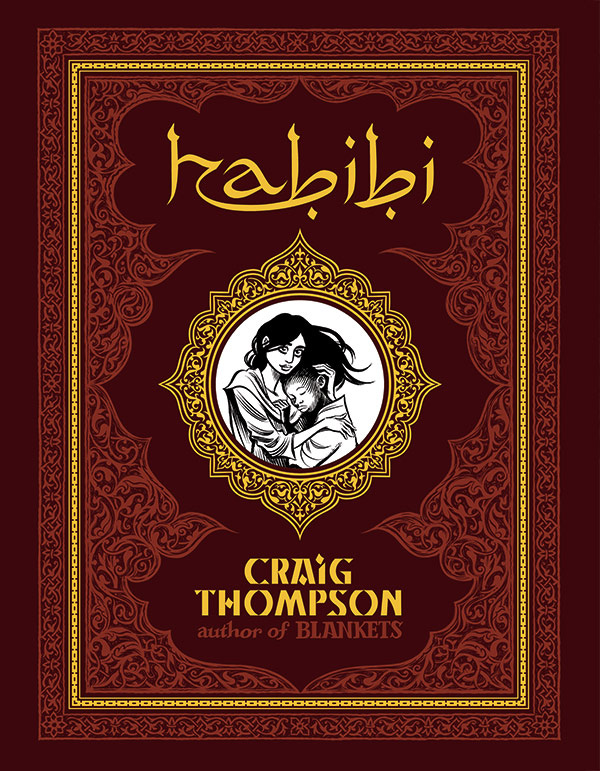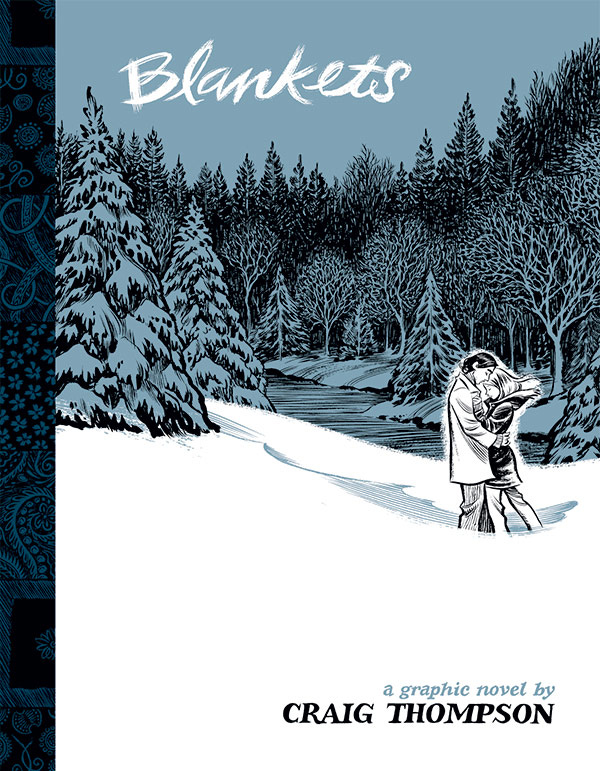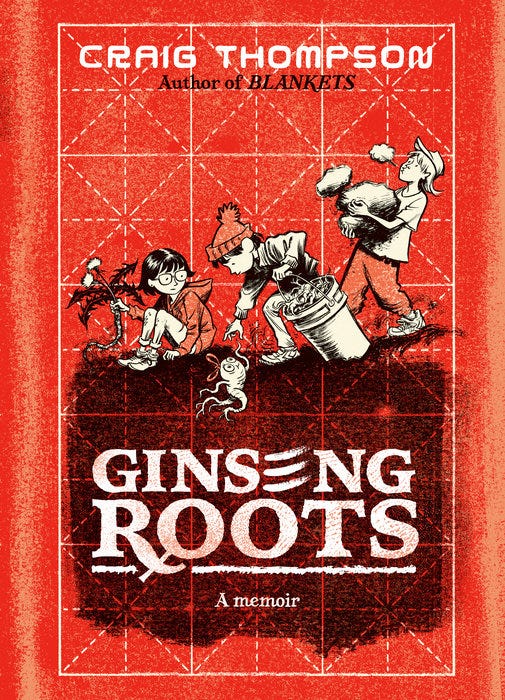Craig Thompson: An Interview
Meet the author and illustrator of Ginseng Roots a graphic novel
Who is Craig Thompson?
CRAIG THOMPSON is a cartoonist and the author of the award-winning books Blankets, Carnet de Voyage, Good-bye Chunky Rice, and Habibi. He was born in Michigan in 1975 and grew up in a rural farming community in central Wisconsin. His graphic novel Blankets has won numerous awards, including the Eisner, Harvey and Ignatz Awards, and has been published in nearly twenty languages.
Craig Thompson, in my book is a legend for graphic novels. He was one of the first authors I picked up in college and thought, wow, now this is a story. The fact that he writes about his life in a visual way spoke to me for years after I got to know is stories in college. If you haven’t checked out his former works before this I suggest you go find his work at the library or wherever it’s sold.
Previous Works


Goodbye, Chunky Rice
Blankets
Carnet de Voyage
Habibi
Space Dumlins
Latest Memoir: Ginseng Roots
Ginseng Roots is more like part two of Blankets. It fills in the blanks to what was left out. Memoirs do this. They tell a slice of life, but not everything. His latest story harkens back to Blankets literally in the book. In a way it’s meta and I have all the feels for it. As a writer and admirer of his work I loved seeing the Easter eggs left in this book. The story follows Craig and his siblings, as they spend summers of their childhood weeding and harvesting ginseng on rural Wisconsin farms. It follows his life without the teen romance and religious upbringing (see Blankets for more on that) but talks about the history of how ginseng got to this sleepy Wisconsin town and the 300 year old history of the global trade of this crop. It shaped how culture and agriculture changed within the American labor market and explained through Craig’s eyes how it happened. One thing I loved is that it was like reading and looking at storyboards of a documentary play out. At times the book broke the metaphorical fourth wall to the audience and the author came out and made commentary about the situation he was writing about.
Where to find Ginseng and Craig Thompson
1. Who are you and what do you do?
My name is Craig Thompson and I’m a graphic novelist. I both write and draw book-length comic books. My newest, Ginseng Roots, is a 448 page memoir about working in ginseng agriculture as a child.
2. Why write this memoir?
The memoir element was reluctant. Initially, I just wanted to write a book about plants. We live in an era of environmental crisis and part of the problem is that we view everything through a human-centric perspective. So I wanted to write a book where a plant was the central protagonist. But what plant did I have a knowledge of or intimacy with? That’s when I remembered a decade of my childhood, ages 10 - 20, working in ginseng agriculture in a small farming town in central Wisconsin - a town of 1,200 people that was the largest producer of cultivated American ginseng in the world.
Ginseng is a medicinal herb prized in Chinese medicine that forged the cornerstone of the trade relationship between China and the US before this was even established as a country. French explorers first recognized the export value of the herb, indigenous to the Americas, as far back as 1718. Then, in 1784, with the ratification of the Treaty of Paris, the newly-established United States sent its first ship to China, loaded up with ginseng, to pay off our debts to France for funding our Revolution. There may not be a United States without ginseng. And I probably wouldn’t have grown up to be a graphic novelist without ginseng. Because I grew up in a poor, working class family with little disposable income. The only way I could accumulate comic books as a child was to buy them myself. And I earned that money working on ginseng farms, working 40 hours a week during my summer “vacations” beginning when I was 10 years old.
3. You have a lot of hilarious and observational dialogue pieces in this book that harken back to Blankets. Why bring up that book in this one? Is this book more like a part 2 in a way?
Blankets was published 22 years ago, but it’s still the book I’m most recognized for. In the past two decades, publishers and readers have pressured me to create a sequel. And I’ve always resisted because I didn't want to repeat myself, and there’s endless pitfalls dealing with writing about one’s real life. But with Ginseng Roots, I found the opportunity to amend some of the omissions and misdemeanors of Blankets. For instance, this book features my sister who was removed from the narrative of Blankets. And my parents are presented with more sensitivity and nuance, written from my mid-life perspective, as I’m the same age as my parents were when Blankets were published and I witness my parents transitioning into vulnerable last chapters of life.
Blankets was written from my memories with reimagined “creative license” dialogue. But the dialogue in Ginseng Roots is written from audio recordings that capture the authenticity of people’s voices.
4. What was the research part like in creating this book? In the story you seem to be pretty transparent that you are recording the story as it's happening on the page.
The research was constant. It actually began with a trip to China in August 2011 where I injured my drawing hand in a minor accident rafting along the Yulong River outside Yangshuo, China. My first medical treatment was a ginseng spray from an herbal pharmacy on the outskirts of town, where I recognized ginseng from my home state of Wisconsin being sold.
After that trip, I began interviewing people - first my immediate family of five, each of which have unique, sometimes contradictory, recollections of that time. Then I interviewed the farmers that were my first employers as a child. All of them have retired from farming since then… So I reached out to the new generation of ginseng farmers that grow at a scale 100 times as large as the small family farms that employed me as a child. I interviewed growers, buyers, distributors, unions and regulators like the Ginseng Board of Wisconsin, Chinese medicine practitioners, and scientists seeking to synthesize and patent the ginsenosides and saponins, the chemical components of the plant, for use in pharmaceuticals.
5. Did you ever feel like you were making more of a documentary than a memoir?
Definitely. Documentary is probably a more accurate description of what this book is. Because other than a few scenes re-imagined from my childhood, the book is based on real-time interviews. I interviewed 80 people for this project (about a dozen made it into the book), recording hours of audio footage, transcribing hundreds of pages… Almost all of the dialogue in the word balloons came directly from these interviews. Before the final pages went to press, I sent them to the interviewees for edits and approval. In fact, the only pushback I received was from my parents. But thankfully, they, too, signed off on the book and gave it their blessing. It made a huge difference to include them in the process, in contrast to Blankets, a memoir I wrote without their knowledge or participation.
6. Did you ever consider turning this story into more than a book? It seems like you collected a lot of research and stories.
Great idea! But no. At some point, it would be satisfying to properly edit and archive all the audio and video footage into a supplement to the book. But not much of it is professional recording quality. It’s just my phone used as a tool to collect the “data.” Making a graphic novel was my only intention.
7. What's next for you?
I’ve been on book tour since September 2024 - over nine months of touring… but in a month, I head to Literary Colloquium in Berlin for a writers’ residency, my first opportunity for unobstructed quiet time to start dreaming of my next project.
8. How long did it take you to create this book? From preproduction/research stages to final version.
Eight years in all. I made my first research/interview trip to Wisconsin in Fall 2016. Then, in December, I moved away from LA and started writing the book on the dining room table of my brother’s place in Minneapolis. During the course of the project, I never re-settled. I moved twelve times between three different cities - Portland, LA, and Minneapolis. During Inktober (an online drawing challenge) of 2018, I started drawing final pages.
The book was first serialized as a twelve-issue comic book series (from Uncivilized Books); the last issue of which was released in September 2023. I was dissatisfied with the narrative arc of the series, so I added an additional seventy pages to the final graphic novel, which was completed in March 2024, more than a year ago. Ever since then, I’ve been focused on design, production, promotion, and nine-month book tour.
9. What advice would you give to the young sequential artist out there who is seeing the scariness of the rise of A.I. and feeling like maybe they can't compete? How do you stay encouraged to keep drawing comics?
As much as A.I. is going to replace EVERY form of human labor, it may actually be re-vitalizing for the arts. Arts flourish during wartime. People thought painting was dead with the invention of photography. Instead, painting became more interesting when it moved beyond photorealism to impressionism and expressionism, emphasizing human capacities that photography could not replicate. AI is already replacing all the generic, formulaic, re-hashed stuff that mainstream media is known for. Audiences hopefully will seek out art that feels more personal, vulnerable, flawed, and human.
10. What was a funny or exciting/adventurous moment you experienced while gathering research for your book?
Well, the drawing hand injury on a bamboo raft on the Yulong River in China was a good start. On my second research to Asia, accompanied by my brother Phil, we were tailed by a television crew filming their own documentary about ginseng. They had just been in our hometown of Marathon, Wisconsin, two weeks prior, interviewing many of the same people I had. But now the camera was turned back towards us, with my brother and I acting as subjects.
My exacerbating hand problems led me on a medical journey that included radiation and surgery and eventually Chinese medicine treatments, via acupuncture and herbs. The acupuncture treatments included me volunteering to be a guinea pig patient on stage in front an audience of more than a hundred practitioners, interviewing me with microphones as they needled me publicly. A funny and humbling moment.
11. If you were stranded on an abandoned island and could only bring 5 things what would you bring?
Assuming a raft and oars are not an option… I would still bring a surfboard for exercise and entertainment. When I lived in LA, I was part of a small posse of cartoonists that joined for surfing once a week, which included Jordan Crane, Steve Weissman, and AJ Dungo - the author of In Waves. As we waited for wave sets to roll in, we’d discuss inking techniques.
Also, assuming you’re not asking for literal, practical necessities for survival like a machete and matches… I’d have to bring a stack of sketchbooks, a brush, and an ink stone, to journal and unravel all my island-bound neurosis.


